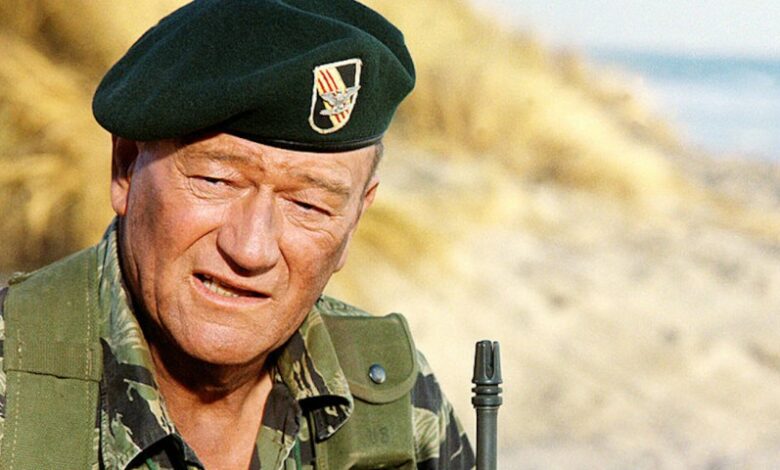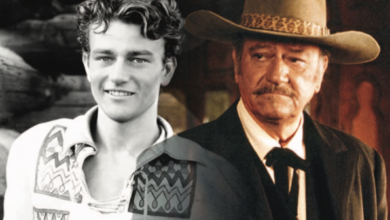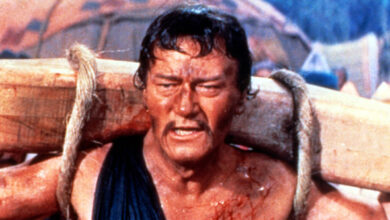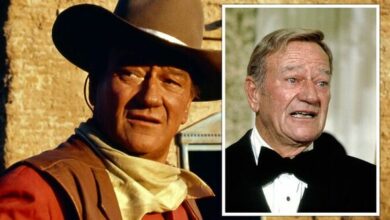Was John Wayne A ‘Draft Dodger’ During WWII?

So I got into a brief exchange on Twitter the other day About John Wayne being a draft dodger in WWII. These claims go back for decades, leveled by biographers, some historians, and some who hate John Wayne for the image he enjoys as the expression of American manhood: Stoic, fair-minded, moral, and forthright. In his films, he tended to portray strong characters that protected the weak and meek often at the cost of great personal sacrifice.
To say that John Wayne was patriotic is an understatement. John Wayne for many Americans is patriotism itself. This is not to say that John Wayne always lived up to the high ideals that his characters embrace, he was a bit of a philanderer and was married three times. That is the problem with high ideals, they tend to be very hard to live up to. Much easier I suppose to embrace low ideals, no ever gets accused of failing to live up to low expectations, do they?
The draft dodging claims are offered under several variations:

John Wayne was a phony who didn’t want to fight in WWII, basically an accusation of cowardice.
John Wayne stayed home and made millions starring in motion pictures while others died in his place.
John Wayne was having a fling with Marlena Deitrich and didn’t want to leave her. This claim is put forward by Marc Eliot in his book “American Titan: Searching for John Wayne,” where he writes, “When she came into Wayne’s life, she juicily sucked every last drop of resistance, loyalty, morality, and guilt out of him, and gave him a sexual and moral cleansing as efficiently done as if she were draining an infected sore.”
Defenders of John Wayne are met with the rebuttal that other famous movie actors had served in uniform like Jimmy Stuart, Clark Gable, Ronald Reagan, and Henry Fonda and Wayne should have done the same. That is a rather simple rebuttal that fails to account for several things, like the way the draft worked during WWII versus voluntary enlistment, and the way Hollywood was brought directly into the war effort by President Roosevelt in a country fully mobilizing for total war against the Axis powers. Finally, as hard as it may be to believe, Gable, Fonda, Reagan, and Stewart were all much bigger stars at the time than John Wayne was. Those guys could pretty much do whatever they wanted in the military(or not do), Wayne was not in that position.
The Draft In World War II Was Nothing Like The Selective Service System That Replaced It
The U.S. adopted a draft system for enlistment in 1940, prior to the start of WWII, the original age was set between 21-35, it was later expanded to age 64. Citizens were responsible for filing registrations themselves. More than 45 million men registered. A lottery system was used to induct new enlistees. After three of these national lotteries, the system then went to one using birthdates, and groups were inducted by age, as in calling up every male born in March 1920. After being called up, there was a pre-induction physical with a rejection rate that ran between 33%-51%. Contrary to uninformed opinions, the military didn’t just take anyone with a pulse. Given the vast numbers being called up, the military rejected lots of enlistees for conditions that were treatable because the government didn’t want to pay for 100,000 hernia operations or replace hundreds of thousands of missing teeth to make men passable on the physical. Some enlistees with skills the military needed, doctors, machinists, mechanics, dentists who were too old or had physical defects would be inducted as not-suitable for combat duty and would remain stateside working in the long logistics tail of a military machine numbering over 12 million men and women in uniform. Nearly 40% of those in uniform were rear-echelon types working in clerical, supply, medical, and other administrative duties.
John Wayne registered for the draft(which is not the act of someone trying to dodge being drafted) and was told he was ineligible to serve because he was married and supporting four children. When Pearl Harbor was attacked, Wayne was just a year short of the age cut off. In 1941 there was no shortage of young men the military could pick from so he received a 3A classification, which was Uncle Sam saying to John Wayne, “Thanks, but we don’t need you.”

By 1943 however, the military still needed men and Wayne was given a 1A eligible status again since the maximum age had been extended to 63. You could no longer just enlist voluntarily either. As it turned out, guys were getting draft notices from the Army and they would dash over to the Coast Guard or Navy office and enlist instead.
When the government caught on to this President Roosevelt signed an Executive Order that ended voluntary enlistments in 1943. The draft system would be the only way into the military. As a result, about 75% of the enlisted men who served in WWII, were draftees.
Upon induction, enlistees were allowed to state a preference for either land or naval forces and by late in the war, even the Marine Corps was receiving draftees, but it all depended on the needs of the government. They would send you where they wanted you to go.
So this was the environment that John Wayne was living in at the time. The only way into the military was through the draft system, and that involved a physical that as many as half of the inductee would fail.
That 1A status that Wayne received was then challenged by Republic Studios which had him under contract to make a picture a year. Under that contract, they could also loan him out to other studios taking half the money paid to him as a commission. John Wayne in 1942 was not yet the star he would become. In 1939 he was ranked the 9th favorite cowboy movie star by fans being polled by trade papers in the movie industry. He had a starring role in Stage Coach that had brought him some fame, but he wasn’t Robert DeNiro in terms of stature yet by any means. Early in the war the Government fully enlisted Hollywood to make movies that kept up morale at home. Perhaps the most famous directors of their era, Frank Capra, John Ford and John Huston were all directly commissioned into the military to make films about why America needed to fight this war. We tend to think of Nazi Germany and Josef Goebbel’s when we turn the word “propaganda” into an image in our heads, but the truth was that Germany’s own propaganda efforts were modeled on our own. They admired us when it came to cranking out propaganda. Republic Studios needed to stay in the picture business to meet its obligations to the war effort at home and they wanted John Wayne deferred. And John Wayne didn’t have any say in that, he wasn’t a free agent, he was an employee.
So the government granted the request. This wasn’t treatment only meted out to celebrities. I had a distant relative who was a Captain in a New York National Guard unit when WWII began. His unit was activated and rolled into the 1st Infantry Division. So he packed his gear, told his employer he was recalled to active duty and was going off to war. His employer happened to be Standard Oil, the largest oil company in the country and he was a petrochemical engineer. Standard contacted the government, told them he was essential to the war effort, and before he could get on the train to go, he was involuntarily but honorably discharged and exempt from further military service. He didn’t like it one bit and tried to protest not just the government’s decision but also Standard Oil’s. He was politely reminded that there was a war on and what he personally wanted didn’t amount to a hill of beans. He would do as he was told, for the good of the country.
So John Wayne really didn’t have any choice here. He wasn’t a free agent, he was working as an employee of Republic and they had asked the government to defer him. Apparently, Wayne didn’t take it very well either. The head of the studio told him that if he tried to quit to join the military the studio would sue him for breach of contract. This begs the question: If the Duke was so determined to avoid being drafted, why would the studio head of Republic have to threaten him with a lawsuit if he left to join the military?
Critics of John Wayne have said that threats like these were common and never enforced, but John Wayne would have had no way of knowing that in 1943, would he?
John Wayne Would Have Failed The Induction Physical
I think there is very good reason to believe that even if John Wayne had been able to break his contract and volunteer he would have failed the induction physical on several disqualifying conditions.
Wayne stood 6 feet 4 inches and was quite an athlete in high school. So good that he had a full scholarship to USC as a football player. There are various reports of his suffering several injuries while in college. He suffered a broken collar bone at some point. Then while body surfing in the ocean off Southern California, he tore a shoulder muscle that never healed properly. Then he had his leg broken during practice his freshman year. Wayne’s injuries were sufficient to prevent him from playing football and he lost his scholarship to USC and dropped out. If these injuries were enough to keep him from playing football in his early twenties, they would certainly have prevented him from finishing boot camp in the Army or Marines at age 34.
Wayne was able to find work as a stunt man for John Ford in numerous westerns. These stunts would have been high falls from roofs and off horses. Wayne suffered injuries to his back that plagued him for the rest of his life. Later in his career, he took to wearing three-inch lifts in his shoes because slipped disks had reduced his height by some three inches.
That’s a lot.
Wayne also suffered from chronic ear infections which affected his hearing.
Wayne’s injuries combined with his age would have probably resulted in his being classified as 4F had he been called up and given an induction physical. Later in the war, the Draft Boards were looking past some things like flat feet, and missing fingers(not thumbs though) to make it’s manpower quotas, but it was doing this for young men, not men in their mid-thirties.

John Wayne Wasn’t A Big Star Like Clark Gable or Henry Fonda Who Did Serve In The Military.
As for the Hollywood leading men who did go to war like Jimmy Stuart and Clark Gable, a couple of points.
Jimmy Stuart was drafted in March of 1941 before the war had broken out. He was initally rejected for service for being too skinny. It is said he then drank a lot of beer for the carbs to get his weight up. The Army accepted him and Stuart got himself into the Air Corps and was taking correspondence courses to become an officer. Stuart was also a private pilot with 400 flight hours as a civilian. When the war did break out, he was already in the military and seemingly bent on a second career(or a change of careers) as a bomber pilot. Jimmy Stuart went on to fly combat missions in bombers over Europe, resumed his acting carreer, and retired from the Air Force a Brigadier General in the reserves.
Clark Gable was 40 when the war started and was beyond draft age or even voluntary enlistment age. He wrote a letter to President Roosevelt after the Pearl Harbor attack asking to join the military and FDR’s response was, “STAY WHERE YOU ARE,” meaning for him to stay in Hollywood making movies and doing war bond drives. His wife Carol Lombard was then killed a month after Pearl Harbor in a plane crash returning from a war bond tour. By some unknown means, Gable managed to enlist, get a billet to officer candidate school and be trained in aerial gunnery and photography. He was then assigned to the First Motion Picture Unit (FMPU) located at what was called “Fort Roach” – the Hal Roach Studios in Culver City, California. The FMPU was commanded by producer Jack Warner, as in Warner Brothers Studio. Jack Warner was probably the string-puller that got Clark Gable into the Army Air Corps at age 40 to go into his unit. Gable spent part of the war stateside making training films but managed to get himself over to Europe to make a propaganda film about B-17 bombing missions over Germany called “Combat America.” He even managed to get himself aboard to for bombing missions several times to film footage and take up a gunners position, as an officer. This was a job for enlisted men. Clark Gable never went to college and had dropped out of high school, and he still ended up with a commission as a Captain.
Gable would finish the film and see it released and requested being dismissed from active duty in 1944 because he was past the age for combat duty and returned to making movies. That request was granted and his discharge was signed by then Captain Ronald Reagan. This was pretty special treatment given to Gable given that a world war was raging. Very few officers could ask to be discharged and go back to being a civilian, you were in for the duration of the war, plus six months according to a decree by FDR. But it was Clark Gable asking and he was a big star at the time, the “King of Hollywood.”
Ronald Reagan was inducted and passed the physical. He didn’t take on Nazi Panzers single-handedly during the Battle of the Bulge, he spent the war in Hollywood making training films for the Signal Corps.
Henry Fonda joined the Navy in August of 1942 because he wanted to be in the war, and not make movies about the war. He refused a commission with two years of college preferring to earn it on merit. He was already a very famous actor when he enlisted making the equivalent of more than $2 million per movie in today’s dollars. He was a Quartermaster on a Destroyer, the USS Satterly. Fonda was 37 when he volunteered, technically past the age of enlistment, but he got a waiver. A year after enlisting Fonda was offered a commission as a full Lieutenant junior grade(O-2), rather than an ensign, again, the justification was his advanced age and success as an actor.
So, Clark Gable wrote his own ticket as the biggest star in Hollywood, the Army initially rejected Jimmy Stuart when we were desperately short of pilots and Ronald Reagan went into the Army to make movies for the Army. All received some special treatment from the government(maybe not in Stewart’s case) to enter the military based on their high celebrity status. In contrast, Wayne did not receive special treatment on his own, but only by the intervention of his employer who wanted to retain him for the war effort.

John Wayne Didn’t Get Rich Sitting Out The War
Which brings me to the next point of criticism about Wanye not serving, that he stuck with the movies so he could cash in as a multi-millionaire while Americans were dying on the Sands of Iwo Jima. I was able to look at what John Wayne was actually getting per movie and it was by no means a shower of riches. Wayne had been on a year-to-year contract with Republic from 1938 to 1943. He made eight films in a serial format called “The Three Mesquiteers.” His lavish salary amounted to just $3,000 a film. That would be worth about $60,000 today. Is that rich? Republic then offered John Wayne a longer contract that ran from just 1943 to 1945. He made eight movies in that time period, including the “Fighting Seabees,” “They Were Expendable,” and “Back to Bataan.” He wasn’t paid big money for any of these pictures. For “Fighting Seabees” Wayne was paid $24,000. That would be about $460,000 today. That’s a pretty good payday, but it isn’t a king’s riches. Last year, Duane, “The Rock” Johnson was paid $50 Million for one movie. It should also be remembered that Wayne paid big taxes on that money in the 1940s, the IRS took 51% of it.
Unlike Clark Gable or Jimmy Stuart, John Wayne was not a big star in 1943, he was a B movie actor, and getting paid like one. He didn’t really become the Legendary John Wayne until at least 1949 with “Sands of Iwo Jima” and “She Wore A Yellow Ribbon.” He was still working for Republic but getting paid better, about $100,000 a picture. This payday jacked John Wayne’s taxes up to 85%. He was probably keeping more money on the movies that kept him in the 51% tax bracket.
People who accuse Wayne of wanting to cash do so imaging him as the megastar John Wayne of the 1950-60s rather than the B movie actor he was in the 1940s.
As to whether he really wanted to serve, it very much appears that he did. He wrote to Director John Ford who was a Commander in the Navy Reserves and headed up a motion picture unit documenting the war practically begging him,
“Have you any suggestions on how I should get in? Can you get me assigned to your outfit, and if you could, would you want me? How about the Marines? You have Army and Navy men under you. Have you any Marines or how about a Seabee or what would you suggest or would you? No I’m not drunk. I just hate to ask for favors, but for Christ sake you can suggest can’t you? No kidding, coach who’ll I see..”
In the National Archives, there are records of John Wayne writing to William Donovan at the OSS begging to give him a job in what would become the CIA. Those archives include his application and an acceptance letter from Donovan himself inviting Wayne into the OSS photographic unit. The letter never reached Wayne. It was sent to his ex-wife who was probably thinking of the alimony she would be giving up and never told him about the letter. It is ironic that biographers give her statements about John Wayne being ashamed about not serving such weight when she herself played a major role in preventing him from serving. It is possible that Wayne contacted Donovan on advice from John Ford for reasons stated above, he really wasn’t the kind of big-name star that Steward, Gable or Fonda were, guys who could pretty much write their own ticket
It is easy,(and also intellectually lazy and bordering on dishonest) to take a single point of data regarding John Wayne’s life in that time and build a draft dodger claim on it while excluding the totality of other things which directly point away to his avoiding service in the military in some way. On some points, like getting rich, the plain facts just don’t support it.
Finally, I think the “John Wayne was a Draft Dodger” claims fail most completely on this single point. In order to “Dodge” the draft it would require at minimum that the dodger get a draft notice, and John Wayne never got a draft notice, something even his most determined critics are forced to acknowledge.





